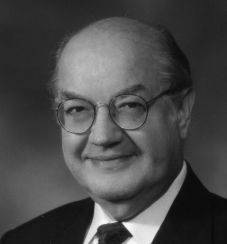In the early 1960s — as an engineer with the RAND Corporation, the U.S. armed-forces think tank founded in the wake of the Second World War — Baran developed a new breed of communication system that could keep running even if part of it was knocked out by a nuclear blast. It was the height of the Cold War, and the nuclear threat was very much on the mind of, well, just about everyone.
Basically, Baran cooked up a system that could divide communications into tiny pieces and use distributed network “nodes” to pass these pieces around. If one node was knocked out, the others could pick up the slack. In 1964, he published a paper on this system — entitled “On Distributed Communications” — and a few years later, it would play into the development of the ARPAnet, the research network that would eventually morph into the modern internet.

Paul Baran passed away in March 2011, but his work lives on — in more ways than one. Earlier this year, he was part of the inaugural class inducted into the Internet Society’s (ISOC) Internet Hall of Fame, taking his place alongside such names a Vint Cerf, Sir Tim Berners-Lee, and Ray Tomlinson.
Baran’s research foretold what became known as “packet-switching,” the basic method for moving information across the internet — and, before it, the ARPAnet. With a packet-switched network, all transmissions are broken into tiny blocks of information known as “packets.” Baran didn’t use the term, but the network he described used many of the same techniques.
“Paul Baran deserves credit of having conceived this notion and showing what it could possibly do and how beneficial it could be,” says Vint Cerf, one of the primary figures behind the creation of the ARPAnet.
That said, at around the same time, others had much the same idea. As Baran was designing his nuke-proof network here in the States, a researcher named Donald Davies was doing similar work at Britain’s National Physical Laboratory, and it was he who coined the term packet-switching. According to Vint Cerf, the work of both Baran and Davies played into the initial design of the ARPAnet, but so did important research from a University of California, Los Angeles professor named Leonard Kleinrock and an engineer named Larry Roberts.
The ARPAnet was a project funded by the Advanced Research Projects Agency, the research arm of the U.S. Department of Defense. In the mid-60s, ARPA hired Roberts to design the network, and Kleinrock was part of the team at UCLA that in 1969 sent the first message between the network’s first two nodes.
There’s some controversy over who deserves the credit for the packet-switching techniques that underpinned the ARPAnet, with some questioning the importance of Baran and Davies to the creation of the Defense Department network. “What Baran was doing was trying to figure out communications in the case of nuclear war, and he came up with packet-switching as one way to do that, but this research was somewhat separate from the later internet,” explains Marc Weber, founding curator of the internet history program at Silicon Valley’s Computer History Museum. But according to Vint Cerf, this controversy was never fueled by Baran himself.
“He was one of the smartest but also the most modest engineers,” Cerf says. “He would very rarely take credit for much, and in particular, he was very conscious of people’s mistaken belief that the work he did at RAND somehow led to the creation of the ARPAnet. It didn’t, and he was very honest about that.”
According to Jim Pelkey — who conducted interviews with Baran, Davies, and Roberts in the 1980s — Roberts laid out the initial design of the ARPAnet before learning of Baran’s work. But Pelkey also says the two men met in the mid-60s — before the ARPAnet went live — and that some of Baran’s ideas directly influenced the network’s eventual architecture. This included Baran’s notion of “hot-potato” routing, a means of juggling packets or “message blocks” on his nuke-proof network. “This just means that if you receive a packet, get rid of it and send it somewhere else,” Cerf says.
But any controversy over Baran’s role in the ARPAnet misses the point. However you slice it, Paul Baran’s research marked a fundamental turning point in the way networks were built. And they’re still built that way.
